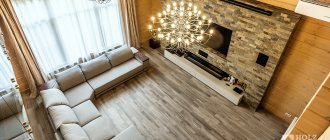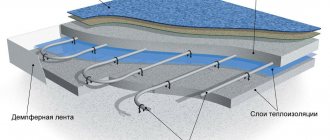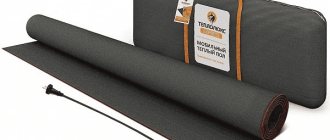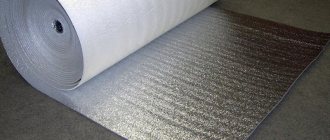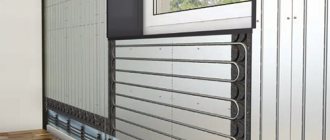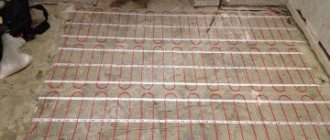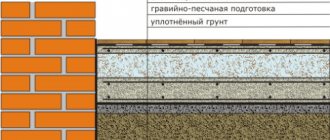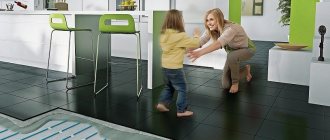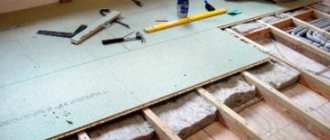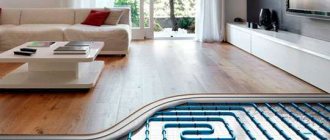Is it possible to install heated floors in the bedroom, all the pros and cons, types of heating systems
Warm floors are used to maintain a comfortable temperature in the rooms. They are used for main room heating or for additional floor heating. Of course, the question arises: in what rooms are such structures installed? Is it possible to use heated floors in the bedroom? To get the answer, it’s worth studying all the pros and cons of such a solution.
Warm floors installed in the bedroom increase comfort
Types of heated floors
There are two energy sources for heated floors: heated water and electricity. The latter option is more often used for local heating, and the first – for autonomous main heating.
Attention! Water floors are a budget option for heating a room.
Water heated floor
Warm floors in the bedroom with liquid coolant are considered durable and less expensive, but problems may arise during installation and maintenance. The structure consists of a pump, pipes and a boiler. There are several ways to install it:
- concrete screed;
- wooden floor;
- laying the finished floor on aluminum sheets;
- self-leveling floor
Electric floor
The installation of an electric heated floor covering in the bedroom is carried out using a special cable and mats made of heating elements. The latest technologies include infrared floors, which are based on rods and films. This floor is used for additional heating. To install an electric heating system, you must comply with some safety requirements:
Electric floor installation diagram
- dry coating;
- installation of thermal relay;
- high-quality insulation and grounding.
Installation of the structure has the following nuances:
- To organize direct exposure, the warm floor is laid as close to the coating as possible.
- Cables and mats are thin, so they are used even in rooms with low ceilings.
- The system is capable of accumulating heat.
Attention! Cable heated floors have a long service life, if you choose the right floor covering - laminate is better suited.
Infrared films
Heating the floor covering in the bedroom using infrared floors involves the passage of electric current with the formation of electromagnetic radiation, which heats the finished floor. In this case, warm air moves across the entire area from bottom to top.
Structures made of mats and cables perform their functions only if the final floor covering is chosen correctly. For them, it is preferable to use laminate, and for film heated floors in the bedroom you can choose carpet, laminate, wood, or linoleum.
Which heated floor to choose for the bedroom?
A bedroom with carpet, parquet or linoleum is a classic of the genre in the world of interior design. It's hard to imagine this room with tiles or tiles underfoot. Today, there are 3 main methods of organizing floor heating:
- Installation of cable heated floors.
- Using thermomats.
- Infrared heating.
Cable underfloor heating is a system with the most complex installation method. If you are doing a major renovation with a floor screed or are building your own house, then there will be no problems with its installation. Among the advantages of this method, it is worth highlighting accessibility (the cable is inexpensive), high efficiency, uniform floor heating and fire safety. But the durability of the system directly depends on the quality of the screed. So, if the concrete is not allowed to gain strength and the decorative coating is applied too early, it may crack, damaging the cable. Also, this technology is not suitable for those who have started cosmetic repairs.
Thermomats are heated floors under tiles, consisting of a thin mesh material with a thin cable laid on it. Heating mats are easy to install, as they are already ready for use. The main advantage of this method is the ease of installation and small thickness. But mats are easily damaged and have strict restrictions on the type of coating with which they can be combined. This technology is used with tiles, porcelain stoneware, mosaics, tiles and natural stone. It is better not to use laminate, carpet and other materials with this type of heated floor.
Infrared heated floors are an innovative technology characterized by safety and excellent performance characteristics. The coating is made in the form of a film with a thin layer of carbon printed into it. Installation of this system does not require specific preparation and can be performed even when redecorating the premises. It is enough to spread the film, perform simple manipulations to connect it, and place the selected floor covering on top. No strings attached or expectations – just warmth and comfort in your bedroom. The only drawback of this technology is its high cost.
The conclusion is obvious: if you want to install a heated floor in the bedroom, it is better to choose an infrared heated floor model. It easily combines with conventional decorative coatings, is durable, safe and highly efficient.
Pros and cons of heated floors in the bedroom
To understand whether it is possible to have a heated floor in the bedroom, it is worth knowing its positive and negative sides. The first include the following:
- A warm floor in the bedroom will forever eliminate damp corners and the development of fungi on the walls, as it eliminates the increase in humidity.
- It is impossible to get a burn from such a heating system, since the temperature on the surface is comfortable for walking barefoot - no more than 30 degrees.
- There is a self-regulation function using additional devices. They automatically control the temperature day and night.
- The installed heating system is invisible to outsiders; you can apply any design, which is limited only by your imagination.
- There are no drafts in the room.
- Savings on heating are up to 30%.
- It is easier to keep the room tidy and clean.
Disadvantages of underfloor heating:
- Comparatively expensive.
- Difficulty in installation, especially during ongoing repairs.
- Non-repairable.
- High requirements for the floor covering that is installed on the heating system - it must have a high thermal conductivity.
Myths about installing heated floors in the bedroom
Many people worry that it is impossible to install heated floors in the bedroom, arguing that they are only suitable for utility rooms and places where people rarely visit. This statement is absolutely incorrect and most likely arose after using low-quality flooring, which emitted unpleasant odors when heated. Today, the market offers many good quality coatings that are environmentally friendly and do not emit harmful substances. Therefore, using heated floors in the bedroom is safe and cost-effective.
The second myth that circulates among consumers: floor heating is not used in the bedroom, since the heat coming from below (close to the head) is harmful to human sleep and health. After all, it is known that during sleep the room should be ventilated. The bedroom requires cool and fresh air. This is right. By the way, we can solve this issue with a heated floor system, since it has the ability to automatically regulate the temperature. Therefore, setting the desired value is easy.
Having studied how a heated floor is installed in a bedroom, the pros and cons of installing it, everyone makes their own choice. However, we should not forget about the large number of advantages and several disadvantages, which are offset by the comfortable conditions in the room.
Laying heated floors in the bedroom:
Myths about the dangers of heated floors
There are several legends about this modern benefit, the absurdity of which has already been proven. The most common myths are:
- The floor is electric.
- Electromagnetic radiation leads to illness.
- The coating emits ultraviolet radiation.
The floor is electric. This myth arose a long time ago and only for the reason that electricity is involved in the heating process. But tell me: does a lamp, laptop or mobile phone get electrocuted? Of course not, because the current-carrying elements in these devices are isolated. This also applies to underfloor heating elements. They have several degrees of protection: from insulation to special sensors that turn off the system if overheated or damaged. The risk of getting an electric shock from the floor is reduced to zero.
Electromagnetic radiation leads to illness. This myth is inspired by the fear of everything new. In fact, the radiation from the floor is an order of magnitude less than from the TV.
The coating emits ultraviolet radiation. This myth arose from the popular comparison of IR emitters to the sun. But this coolant is capable of producing only a useful spectrum of radiation in the infrared range, and not ultraviolet waves. Otherwise, the heater would not be called infrared, but ultraviolet (see figure below).
In general, if you decide to have heated floors in your bedroom, then you should give preference to an infrared heat source. This way you will get comfortable and safe coverage.
Video text
A gift from our channel: a large (156 pages) guide to underfloor heating. https://teploclub.com/blog/Podpiska/Al.
Many people deliberately deprive themselves of the pleasure of having TP in the bedroom. Usually the argument is that somewhere it is written that you need to sleep in a cool room, otherwise you will get a headache, and that thermal radiation has a bad effect on your head and overall well-being, and a warm floor cannot provide the desired comfortable climate in the bedroom. I will now give all the arguments for warm floors in the bedroom that I can remember. You can add in the comments what I missed. Or, on the contrary, give killer counterarguments that will convince me to abandon such an idea. And so, first, about the advantages in general. 1. Warm floors are more economical than radiator heating. 2. Warm floors allow you to maintain a stable temperature with minimal fluctuations. 3. If an accident occurs, the cement screed retains heat for a long time. 4. The screed can accumulate heat from solid fuel boilers, as an alternative to water heat accumulators. 5. It's easier to make any design decisions because the batteries don't get in the way. 6. It is easier to clean the floor if radiator pipes do not stick out from the floor. 7. Heated floors can be easily installed even by a beginner. 8. Warm floors are durable and reliable. 9. Installation of light heated floors is now available. 10. For me, warm is better than cold. 11. More arguments “For”. • Russian stove. • Chambers. • High bed legs. • Heated hydro mattresses. • Korean tradition of heated floors and baths. 12. Thermal radiation from the floor is perfectly shielded by the mattress and pillow. 13. There are no regulatory restrictions on the use of heated floors in sleeping areas, including in kindergartens and nurseries. 14. We can set the temperature we need • Room thermostat and servos on the manifold. • Any desired temperature at any specific time. • You can place the thermostat at bed level. • One or two branches can be adjusted separately to the desired result. True, depending on the weather, you will have to reconfigure. Use a good finish, not cheap laminate or linoleum.
I will send you SNiP, where in paragraph 3.16 there is a table of permissible temperatures for the surface of structures with built-in heating elements. Including for TP. I will also send my subscribers a link to my video about a light heated floor, when you have wooden floors and you cannot pour a cement screed on a water heated floor. And a couple of links to the websites of manufacturers of plates and mats for light heated floors.
Many people have difficulties when it comes to selecting the installation step of the heating system and the temperature of the coolant if they know what kind of finished floor covering you will have and what heat loss this water-heated floor should provide. At the same time, you also need to not go beyond the temperature recommended by SNIP. And I will send you this table. I have already sent it to my subscribers, and who else, by some absurd accident, is not my subscriber, follow the link, subscribe and receive it right in a couple of minutes.
Friends, I hope I convinced you to lay warm floors in your bedroom. Do not deny yourself comfort and do not take false fears for granted.
Share with your friends. This is the best thank you for my time. I still have a lot to tell you. Sign up for the VKontakte group and the mailing list of my educational materials. Sergey Volkov.
Is it possible to install heated floors in the bedroom? Pros and cons.
Many people deliberately deprive themselves of the pleasure of having TP in the bedroom. Usually the argument is that somewhere it is written that you need to sleep in a cool room, otherwise you will get a headache, and that thermal radiation has a bad effect on your head and overall well-being, and a warm floor cannot provide the desired comfortable climate in the bedroom. Do not deny yourself comfort and do not take false fears for granted.I will give all the arguments for warm floors in the bedroom, read on. Or, on the contrary, give killer counterarguments that will convince me to abandon such an idea. And so, first, about the advantages in general. 1. Warm floors are more economical than radiator heating. 2. Warm floors allow you to maintain a stable temperature with minimal fluctuations. 3. If an accident occurs, the cement screed retains heat for a long time. 4. The screed can accumulate heat from solid fuel boilers, as an alternative to water heat accumulators. 5. It's easier to make any design decisions because the batteries don't get in the way. 6. It is easier to clean the floor if radiator pipes do not stick out from the floor. 7. Heated floors can be easily installed even by a beginner. 8. Warm floors are durable and reliable. 9. Installation of light heated floors is now available. 10. For me, warm is better than cold. 11. More arguments “For”.
- Russian stove.
- Chambers.
- High bed legs.
- Heated hydro mattresses.
- Korean tradition of heated floors and baths.
12. Thermal radiation from the floor is perfectly shielded by the mattress and pillow. 13. There are no regulatory restrictions on the use of heated floors in sleeping areas, including in kindergartens and nurseries. 14. You can adjust the temperature we need.
- Room thermostat and servos on the manifold.
- Any desired temperature at any specific period of time.
- You can place the thermostat at bed level.
- One or two branches can be adjusted separately to the desired result.
True, depending on the weather, you will have to reconfigure.
Use a good finish, not cheap laminate or linoleum. I will send you SNiP, where in paragraph 3.16 there is a table of permissible temperatures for the surface of structures with built-in heating elements. Including for TP. I will also send my subscribers a link to my video about a light heated floor, when you have wooden floors and you cannot pour a cement screed on a water heated floor. And a couple of links to the websites of manufacturers of plates and mats for light heated floors.
Many people have difficulties when it comes to selecting the installation step of the heating system and the temperature of the coolant if they know what kind of finished floor covering you will have and what heat loss this water-heated floor should provide. At the same time, you also need to not go beyond the temperature recommended by SNIP. And I will send you this table. I have already sent it to my subscribers, and who else, by some absurd accident, is not my subscriber, follow the link, subscribe and receive it right in a couple of minutes.
Friends, I hope I convinced you to lay warm floors in your bedroom. Do not deny yourself comfort and do not take false fears for granted.
Share with your friends. This is the best thank you for my time. I still have a lot to tell you. Sign up for the VKontakte group and the mailing list of my educational materials. Sergey Volkov.
Myths about installing heated floors in the bedroom
At the time the first prototypes of heated floors were used, the system was far from perfect, so it managed to acquire myths that are no longer relevant. The most popular myth is that the floor temperature is too high, which will “burn your heels.” In fact, this is impossible. Warm floors are a low-temperature system, so it is impossible to get burns or simply unpleasant sensations.
The second most popular myth is low thermal efficiency, due to which underfloor heating is only capable of heating the room to a comfortable temperature. This one is a little more complicated. When heated floors first began to appear, it was indeed a low-power system. Today, underfloor heating can be used to heat the entire house without any temperature problems. One of the reasons for the myth is the fact that underfloor heating is a low-temperature system. But she does not need high temperatures: this can cause overheating and burns of the legs, and too high a temperature in the room. There is no need for high coolant temperatures; a warm floor can provide and maintain a comfortable environment with low coolant temperatures.
Types of heated floors
There are several types of heated floors today. The choice depends on the needs of each individual person and the characteristics of connecting to heat sources.
Water heated floor
Water
Water-based floors require thick screeds and high costs during installation. For water pipes, the correct installation of the collector, a drawn diagram of the pipe “snake”, and the correct installation of this pipe are required. All this is associated with certain difficulties. In addition, in order to correctly delineate the places where the pipes will pass, you will have to contact a heating engineer.
But at the operating stage, a water floor is more economical than an electric one. The cost of heating water has always been less than the cost of electricity. The only disadvantage of using water heating systems is the failure of the collector. The collector needs to be changed every 5 years, since the old one quickly becomes clogged and corroded, which can lead to damage to the system as a whole.
Installing sensors and a thermostat can save even more money. So, using a timer, you can set the heating to warm up just before you come home from work, or warm up the floor more strongly before going to bed - everything is done not only to save money, but also for human comfort.
To connect a warm water floor in the bedroom, you need to configure the boiler correctly. You cannot heat the entire house with water at a temperature of 70 degrees and supply it to the heated floor. Warm floors are a low-temperature system; the coolant in it should not exceed 60 degrees.
Unfortunately, such a floor cannot be installed in an apartment. Due to the additional water consumption, the hydraulic mode of the building's heating system changes greatly. This can cause the system to become unbalanced, leading to the failure of individual radiators throughout the house. Therefore, not a single BTI will issue permission to install a water heated floor in an apartment. Or rather, not for installation, but for connecting this floor to the citywide central heating system.
Electric heated floor
Electric
The electric floor was developed specifically for residential heating. This is a heating cable that is sold in two variations:
- In the form of a single cable, which is secured with staples or placed in the grooves of rubber plates
- In the form of a thin cable strung on a mesh base that simply rolls out across the floor
In the second case, installation is simpler: there is no need to draw a “snake” of the heated floor, just roll out the mesh, secure it with brackets and continue installing the floor. For electric heated floors there is no need for a thick screed. If a water floor makes the entire surface of the floor a heating device, then the cable itself is a heating device, so there is no need for a thick screed. The cable is not so susceptible to mechanical stress. All this, together with operation from a simple outlet, would make the electric floor a market leader, if not for the price of electricity. Special sensors and regulators can significantly reduce costs, but operating costs will still remain at a fairly high level.
Infrared film floor
Infrared film
Infrared film is an intermediate model between water heated floors and electric ones in terms of costs. For installation, you do not need a screed at all; you can use ordinary chipboard slabs, which are then covered with laminate or any other covering. The principle of infrared film is to pass electricity through a thin aluminum film secured between two insulators. Due to the small cross-section of aluminum, electricity consumption and heat dissipation are reduced.
This option is considered the most successful, but it is not suitable for large rooms, since the likelihood of mechanical impact on the film through the thickness of the floor increases. And through a floor that is too thick, the heat simply will not reach the room.
Pros and cons of heated floors in the bedroom
The advantages of heated floors in the bedroom are obvious:
- More favorable temperature conditions in the room. A warm floor spreads heat using electromagnetic waves. Such heating has a beneficial effect on a person’s well-being and performance. Studies have shown that in a better temperature environment, it is easier for a person to fall asleep and sleep more pleasantly, which is especially important for the bedroom.
- Easy to use. Conventional radiators accumulate dust; this is largely due to convection, which heats the room. Air currents move dust throughout the room. Air does not participate in radiative heat exchange between the floor and surfaces in the bedroom, which means there will be less dust on high surfaces and in the air.
- Economical. Economy refers to system parameters. Warm floors are low-temperature heating, that is, less fuel is spent on heating the coolant, which means the system is more economical than conventional convective heating. As for the electric heated floor, it is more economical than an electric boiler of equivalent power.
Warm floors in the living room, bedroom, nursery
Comfortable air temperature in the bedroom is a very important component for well-being and overall health. The body is negatively affected by too dry air, which inevitably appears due to hot radiators during the heating season.Warm floors create a comfortable temperature, evenly warming the room over the area and dry out the air much less. In children's rooms, heated floors are most justified, since children love to play on the floor. When installing heated floors in a nursery, there is no need to use heating devices with sharp corners or hot parts. Warm floors are safe for children and will not cause injuries. The heated floor system makes it possible to regulate the air temperature in the room.
An electric heated floor creates a minimum of harmful radiation (if installed correctly, it is lower than the radiation from a smartphone).
Main heating (200 W/m²) | |
| up to 0.5 m² | 0.5 m²-1 m² | 1 m²-2 m² | 2 m²-2.5 m² | 2.5 m²-3 m² | 3 m²-3.5 m² | 3.5 m²-4 m² | 4 m²-4.5 m² | 4.5 m² -5 m² | 5 m²-5.5 m² | 5.5 m²-6 m² | 6 m²-6.5 m² | 6.5 m²-7 m² | 7 m²-7.5 m² | 7.5 m²-8 m² | 8 m²-8.5 m² | 8.5 m²-9 m² | 9 m²-9.5 m² | 9.5 m²-10 m² | 10 m²-10.5 m² | 10.5 m²-11.5 m² | 11.5 m²-12 m² | 12 m²-13 m² | 13 m²-14 m² | 14 m²-16 m² | 16 m²-18 m² | 18 m²-20 m² | 0.5 m²-1 m² | 1 m²-1.5 m² | 1.5 m-2 m² | 2 m²-2.5 m² | 2.5 m²-3 m² | 3 m²-3.5 m² | 3.5 m²-4 m² | 4 m²-4.5 m² | 4.5 m²-5 m² | 5 m²-5.5 m² | 5.5 m²-6 m² | 6 m²-6.5 m² | 6.5 m²-7 m² | 7 m²-7.5 m² | 7.5 m²-8 m² | 8 m²-8.5 m² | 8.5 m²-9 m² | 9 m²-9.5 m² | 9.5 m²-10.5 m² | 10.5 m²-11.5 m² | 11.5 m²-13 m² | 13 m²-16 m² |
Selecting a film heated floor based on the area of the heated surface: |
| 0.5 m² | 1.0 m² | 1.5 m² | 2.0 m² | 2.5 m² | 3.0 m² | 3.5 m² | 4.0 m² | 4.5 m² | 5.0 m² | 6.5 m² | 7.0 m² | 7.5 m² | 8.0 m² | 8.5 m² | 9.0 m² | 10.0 m² | 11.0 m² | 13.0 m² | 15.0 m² | 17.0 m² | 18.0 m² | 19.0 m² | 20.0 m² | 21.0 m² | 22.0 m² | 23.0 m² | 24.0 m² | 25.0 m² | Heating film for cutting | Film in rolls |
Quick transition to sections:
Read more about the types and basic technicalities. characteristics of electric heated floors:
Heating mats
| Cable sectionsWhen using this type of heated floors, it becomes necessary to significantly raise the floor level in the bathroom or toilet, since the cable section is mounted in a concrete screed. They are reliable and safe to use, although their installation is quite complicated, time-consuming and costly. Due to its low cost and low energy consumption, this type of heated floor is very popular. | ||
Film heated floorThis type of heated floor is laid under parquet and linoleum, which are rarely used as flooring in bathrooms and toilets. Due to the technological design features of film systems, we do not recommend installing them in wet rooms, even despite their main advantage - they do not require raising the floor level. Installing a film floor in a bathroom is not a rational solution, requiring professional knowledge and skills during installation, as well as increased financial costs. | Thin heating mats
|
OUR ADVANTAGES:
Heating Lux™
+7 812 648-24-84;;
CALL! We will be happy to advise you!
Return to top |
